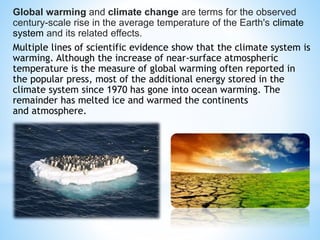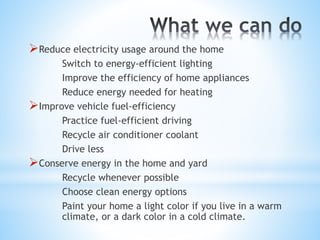Global warming, its consequences and possible steps
- 1. Necsoi Sorin Alin Group 8218
- 2. Global warming and climate change are terms for the observed century-scale rise in the average temperature of the Earth's climate system and its related effects. Multiple lines of scientific evidence show that the climate system is warming. Although the increase of near-surface atmospheric temperature is the measure of global warming often reported in the popular press, most of the additional energy stored in the climate system since 1970 has gone into ocean warming. The remainder has melted ice and warmed the continents and atmosphere.
- 3. Future climate change and associated impacts will differ from region to region around the globe. Anticipated effects include warming global temperature, rising sea levels, changing precipitation, and expansion of deserts in the subtropics. Warming is expected to be greater over land than over the oceans and greatest in the Arctic, with the continuing retreat of glaciers, permafrost and sea ice. Other likely changes include more frequent extreme weather events including heat waves, droughts, heavy rainfall with floods and heavy snowfall; ocean acidification; and species extinctions due to shifting temperature regimes. Effects significant to humans include the threat to food security from decreasing crop yields and the abandonment of populated areas due to rising sea levels.
- 4. The climate system can warm or cool in response to changes in external forcings. These are "external" to the climate system but not necessarily external to Earth. Examples of external forcings include changes in atmospheric composition (e.g., increased concentrations of greenhouse gases), solar luminosity, volcanic eruptions, and variations in Earth's orbit around the Sun. The greenhouse effect is the process by which absorption and emission o f infrared radiation by gases in a planet's atmosphere warm its lower atmosphere and surface.
- 5. More Powerful and Dangerous Hurricanes Warmer water in the oceans pumps more energy into tropical storms, making them stronger and potentially more destructive. Even with storms of the same intensity, future hurricanes will cause more damage as higher sea levels exacerbate storm surges, flooding, and erosion.
- 6. Drought and Wildfire Warmer temperatures could increase the probability of drought. Greater evaporation, particularly during summer and fall, could exacerbate drought conditions and increase the risk of wildfires. Intense Rainstorms Warmer temperatures increase the energy of the climatic system and can lead to heavier rainfall in some areas. Scientists project that climate change will increase the frequency of heavy rainstorms, putting many communities at risk for devastation from floods.
- 7. Bad Air, Allergy and Asthma Global warming could increase smog pollution in some areas and intensify pollen allergies and asthma. Hotter conditions could also aggravate local air quality problems, already afflicting more than 100 million Americans. Infectious Disease and Food and Waterborne Illness Outbreaks Warming temperatures, alternating periods of drought and deluges, and ecosystem disruption have contributed to more widespread outbreaks of infections like malaria, dengue fever, tick-borne encephalitis, and diarrheal illnesses. People living in poverty will be hardest hit by the global surge in infectious diseases.
- 8. Reduce electricity usage around the home Switch to energy-efficient lighting Improve the efficiency of home appliances Reduce energy needed for heating Improve vehicle fuel-efficiency Practice fuel-efficient driving Recycle air conditioner coolant Drive less Conserve energy in the home and yard Recycle whenever possible Choose clean energy options Paint your home a light color if you live in a warm climate, or a dark color in a cold climate.
- 9. 1. https://en.wikipedia.org/wiki/Global_warming 2. http://learn.eartheasy.com/2009/03/global- warming-climate-change-what-we-can-do-about-it/ 3. http://www.nrdc.org/globalwarming/fcons.asp








